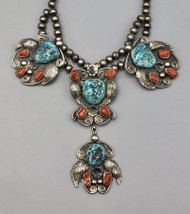Dating Jewelry - Leaf Appliqué
Posted by Jim Olson on Jul 5th 2018
When you see leaf (or feather) appliqué on a piece, the general rule of thumb is to automatically think—1970s. Then you further assess the item and go up (or in rare cases) down from there, as necessary.
But first, what is feather or leaf appliqué and when did it come about? Simply put, they are those little leaf (feather) looking designs which adorn many pieces of Native American jewelry. Appliqué [app-lee-kay] is a fancy French word which simply refers to “a decoration or trimming affixed onto another.” In other words, “Applied.”
As to the question, “When did it come about?” A good thing to keep in mind is the old adage, “Ask 10 different experts for an opinion and you will most often get 10 different opinions!” But seriously, a little research and personal experience has shown us the very earliest examples of it began to appear in the late 1950s. On page 48 of, Indian Silverwork of the Southwest, by Harry Mera (published in 1959), you can see a bracelet with appliqué that looks very much like the forerunner of the leaf and feather appliqué designs which became so popular a generation later.
I also am in possession of a silver and turquoise ring, which was a presented as graduation gift in 1958. It has appliqué in the form of a leaf. I could find no examples in old photographs or publications which led me to believe that leaf or feather appliqué was used earlier than the late 50s. Although it may be possible. Also, it should be noted that these early examples were of the “handmade” variety, and not “castings” (like you often see in appliqué designs). It should also be noted the leaf appliqué were rarely used until you get into the 1960s.
By the mid-1960s however, the mass-produced, machine or “cast” pieces of appliqué were widely available. These castings gained in popularity as the jewelry boom of the late ‘60s and ‘70s gained momentum. The ease and time saving aspects of pre-made appliqué led to many silversmiths producing jewelry that contained largely “assembled” parts they would buy, ready-made, from the jewelry supply house. Leaf / feather appliqué was among the most popular.
At first, the leaf was used more as an accent. However, by the mid-70s and into the early 80s, excess took over. If you see a vintage looking piece of Native Jewelry that is so covered in appliqué, that it is pretty much a big ol’ collage of nothing else, think 1980 (and big hair, LOL). The height of excessive use of appliqué seems to have come in the late 70s thru early 80s. It started to taper off and become more of an accent again as you closed in on the turn of the century however.
Another question that often comes up is, “Is that a feather or a leaf?” Good question. I think it is often supposed to be a leaf (that is how the jewelry supply store sells them). However, much of the time it does indeed look more like a feather than a leaf. Some times it is obviously one or the other, the rest of the time, it can be what ever you want it to be. In some cases, it is up to the interpreter.
Although this type of appliqué is still in use on some modern-day jewelry, it has toned down quite a bit and is once again more of an accent than a focus. From the mid-60s to now, most of those feather appliqués used are castings, bought at the jewelry supply house. However, some of the better silversmiths hand-make their own, to stay more inline with keeping their stuff in a truly “handmade” category.
So the next time you are shopping for jewelry and somebody tells you, “This is an early piece,” or they say, “This was my great grandma’s and she got it before WWII.” Look very closely, and if it has the feather or leaf appliqué, you’ll know it is much later, like circa 1970s, or later in most cases.
Jim Olson ©2018

